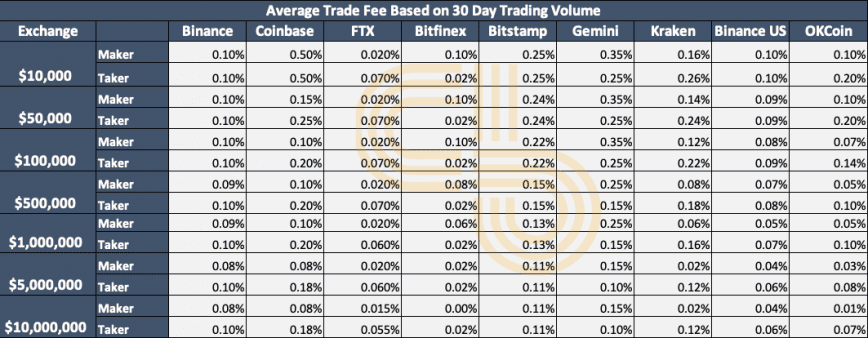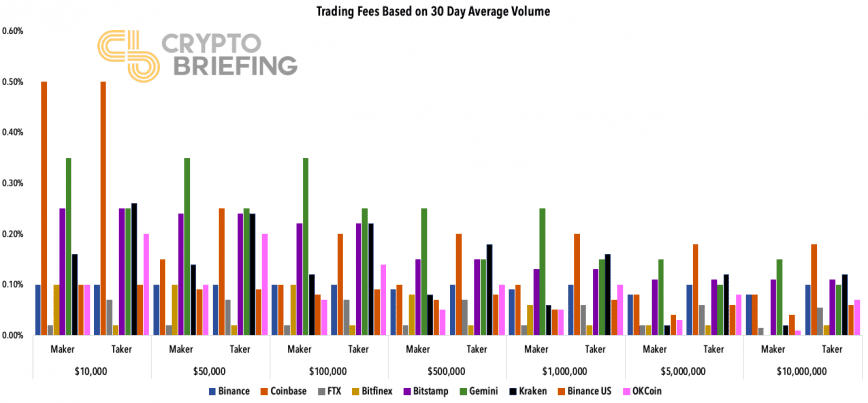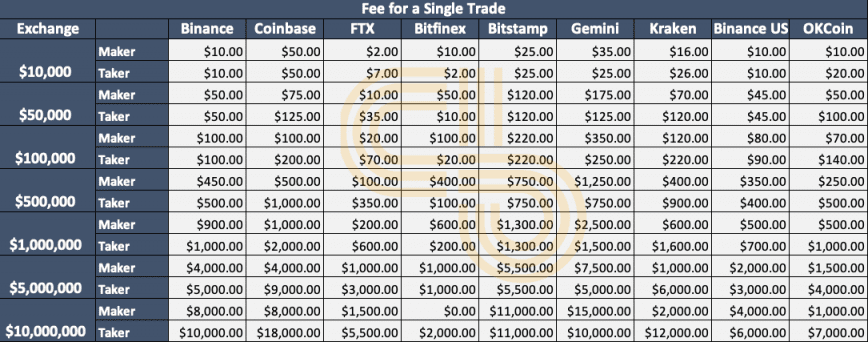Comparing Trading Fees Between the Top Bitcoin Exchanges
Maximizing gains as a cryptocurrency trader also means minimizing any and all losses. That's why choosing the most inexpensive trading platform should be part of any veteran trader's strategy.

Key Takeaways
- Typically, the more crypto you trade on a daily or monthly basis, the lower your exchange fees.
- Exchanges domiciled in the United States are far more expensive than those based elsewhere.
- Phemex offers a unique, one-time subscription fee that can make sense for many traders depending their monthly trading volume.
Share this article
Trading fees on cryptocurrency exchanges can destroy even the most experienced crypto user’s gains. Especially for day and swing traders, picking the right cryptocurrency exchange is just as important as a sound trading strategy.
It’s no secret, the more you trade the more you pay. Exchanges make their money from trading fees, while whales make up the bulk of exchange revenues. But you don’t want to be a cash cow for an exchange. Your goal is to keep as much of your hard-earned gains as possible. Trading on the right exchange is a big part of optimizing profits.
We put together a list of the top exchanges and their fee structures so you can make an informed choice before settling on one.
The size of a trader’s positions and their average monthly volumes decide which fee bracket they fall into. Higher volume traders tend to get substantially lower fees on most exchanges. Additionally, adding liquidity to the order book (through maker trades) is often cheaper than traders that take liquidity out of the orderbook (taker traders).
Measuring Crypto Exchange Trading Fees
It’s obvious that the more you trade, the more you will pay in fees. But, the marginal cost for higher volume varies between exchanges.
Take a look at the maker and taker fees across volume sizes for a few top exchanges:

Upon first glance, most cryptocurrency exchanges seem to have very similar structures. Some of them stand out from the rest. FTX’s low fees and Gemini’s high fees are immediately visible, for instance.
Digging a little deeper, it seems that FTX continues to be the cheapest exchange for most traders. One would think this is an additional incentive to get liquidity on the exchange, but FTX has close ties with Alameda Research, one of the largest market makers in crypto.
Bitfinex, too, has very reasonable rates that start off at average and decrease at a higher rate than normal. This makes it a premier exchange for traders doing millions of dollars in monthly volume, if you can stomach its questionable reputation.
Gemini’s ActiveTrader product is the most expensive exchange by a significant margin—even at higher trading values. In fact, a $500,000 maker order on Gemini would pay more fees than a $5,000,000 maker order on Bitfinex, FTX, or Kraken.
Coinbase Pro is also fairly expensive. At a taker fee of 0.18% in the $10,000,000 category, Coinbase is one the least cost-effective exchanges for large traders.
When you put the data together, a few trends become obvious.

Three of the most expensive cryptocurrency exchanges are Coinbase, Gemini, and Kraken—all domiciled in the United States. The cost of doing business for a crypto exchange in the U.S. exceeds that of any other jurisdiction due to regulatory costs. Exchanges located in the U.S. need to implement higher fees to offset their increased costs.
This is further corroborated by the fact that FTX, Bitfinex, and Binance, three crypto exchanges that do not cater to U.S customers, have the cheapest fees.
Binance U.S doesn’t seem to suffer from the high fees of its local competitors. The exchange is less than a year old, so lower fees are probably a part of its business strategy to attract more high-volume customers.
For the sake of simplicity, assume a trader makes only one trade a month. How much money would each trader shell out at each fee bracket?

This simulation offers an insightful case study into how exchange fees can translate into real costs. With only one trade, FTX and Bitfinex remain the most cost-effective exchanges across every single bracket.
Coinbase Pro and Gemini ActiveTrader fees are quite absurd, but their target audience is not retail, but more professional investors. For this reason, the high fees are justified by the ease of execution they provide large scale investors with.
However, the more conscious trader would obviously prefer to pay a $1,500 fee on a trade at FTX rather than $15,000 for the same trade at Gemini. At some point, the large amount of potential cost savings will cause customers to re-think their decision if alternatives that are 10-times cheaper exist.
The Subscription Model Is a Gamechanger
Fees can make or break profitability. For an active trader, constantly adjusting a position or laddering into orders can prove to be very expensive.
A subscription fee to trade spot markets can drastically reduce costs for large traders while making exchange revenue more predictable. The only downside is that smaller traders may not get their fill to ensure they are getting the best bang for their buck. However, the mental ease of paying a one time cost and not worrying about fees for a year is attractive.
Phemex is the first major exchange to implement a subscription-based fee model for crypto spot markets. Traders pay a monthly fee of $10 or an annual $70 fee for access to Phemex’s spot liquidity. Each trade thereafter is executed with no fees, and the program has no limits on the number of trades and more frequent withdrawals.
This means whether you trade $100 a month or $100,000,000, you pay the same $70 fee. Looking at the simulation table above, it’s clear that this model works in the favor of traders that have $10,000 of volume or more.
At $70 a year, any entity trading over $5,833 on Binance or Bitfinex would save money by using Phemex.
Let’s say you have $5,000 of monthly trading volume on Binance. This entails monthly fee payments of $5. Over the course of a year, this trader would pay $60 in fees, which is lower than Phemex’s subscription rate.
If they traded $70,000 over the course of the year, however, fees would tally up to $70, matching the Phemex yearly subscription rate.
WIth $6,000 of monthly volume, yearly fee payments rise to $72. Here, using Phemex would result in minor savings for those using even the cheapest cryptocurrency exchanges.
The endgame here is clear—the more you trade, the greater the potential savings on a subscription-based model.
Though liquidity on Phemex is behind other big spot exchanges, the platform is less than a year old and is already processing billions of dollars in trades per month. Orderbook depth should grow as the novel subscription model attracts new traders.
Disclosure: Phemex is Crypto Briefing’s preferred derivatives partner.
Share this article
